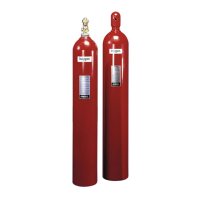VI. Accidental Release Measures
Personal Precautions:
Respiratory Protection: (See Section VIII)
Hand Protection: (See Section VIII)
Eye Protection: (See Section VIII)
Skin and Body Protection: (See Section VIII)
Clean up Precautions: None, material is a mixture of normal atmospheric gases.
Waste Disposal Methods: None, material is a mixture of normal atmospheric gases.
VII. Handling and Storage
Handling: Normal precautions for handling high pressure gas cylinders.
Storage: Store cylinders with restraints to prevent possibility of rupture.
VIII. Exposure Controls/Personal Protection
Respiratory: The normal discharge of INERGEN at its designed concentration between 34 and 70 % V/V in a fixed enclo-
sure does not present any hazard. Exposure at concentrations above these limits requires the use of self-
contained breathing apparatus. Other respirators will not protect in an oxygen deficient atmosphere.
Local exhaust and Mechanical (General) Ventilation: Use as required.
Hand: Leather gloves are recommended for handling compressed gas cylinders.
Eye: Chemical goggles or safety glasses are recommended.
Skin and Body: No specific protection is needed.
IX. Physical and Chemical Properties
Appearance: Gas.
Color: Colorless.
Odor: Odorless.
Relative Density (H
2
O = 1): 0.084 lbs./ft
3
Solubility in Water: Slight.
pH (If in water, % Conc.) : 7
Boiling Point: –320 °C
Vapor Pressure (mm Hg): 2205 psi @ 70 °F
Vapor Density (Air =1): 1.0
Flash Point: None.
Flammability Limits in Air
(% by volume): Nonflammable.
Autoflammability Nonflammable.
Explosive Properties: Not explosive.
Oxidizing Properties: Not an oxidant.
X. Stability and Reactivity
Stability: Stable Unstable □
Conditions to Avoid: None.
Hazardous Reactions: Will not occur May occur □
Conditions to Avoid: None.
Materials to Avoid: None.
Hazardous Decomposition Products: None.
XI. Toxicological Information
Carbon Dioxide:
Toxicity Data: Inhalation (human) LCLO 100,000 ppm/min.
Argon:
Exposure can cause: Nausea, dizziness and headache.
Page 2INERGEN (Continued)

